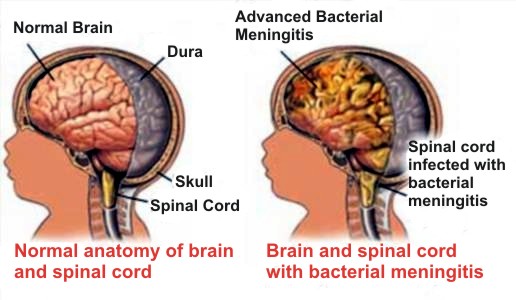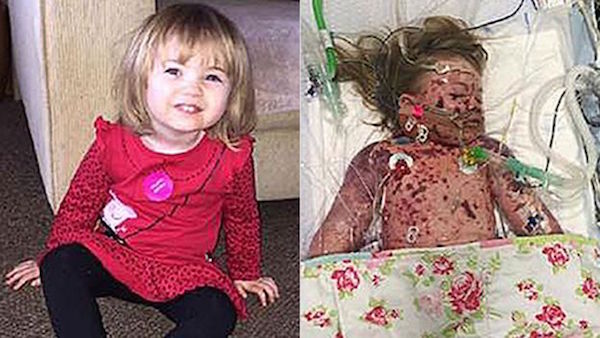
This disease can be fatal and should always be considered a medical emergency
Amy**, a 4 year old girl suffered fever, ‘rash’, headache and vomiting and never recovered. It was quick, the symptoms didn’t seem fatal and it didn’t occur to her mother she would be a victim of meningococcal meningitis. The whole village was not vaccinated against meningococcal meningitis and some children were infected. – Prof. Lulu C. Bravo.
No mother should see her child suffer Meningitis and suffer the loss of her child. Meningitis is life-threatening bacterial infection that affect the brain and spinal cord, it is an acute inflammation of the thin membranes covering the brain and spinal cord. Symptoms include fever, headache and neck stiffness; confusion or altered consciousness, vomiting, and an inability to tolerate light or loud noises are also symptoms.
Bacteria and viruses are the two main causes of meningitis. There is a bacterium Neisseria meningitidis (also termed meningococcus) that causes meningococcal meningitis. Meningococcus is the most common cause of bacterial meningitis in young children and teens; and it may be accompanied by a characteristic rash. In adults, it is the second most common cause.
Meningitis is a serious infection and its fatal in 50% of cases if left untreated. Bacterial meningitis – the most severe and common form of meningitis – causes 120,000 deaths globally every year. Infants, young children and adolescents are most vulnerable. As symptoms, mentioned above, are similar to that of common viral illnesses, such conditions can be hard to recognise especially in its early stages.

DEVASTATING CONSEQUENCES IN JUST 24 HOURS
Meningitis can develop quickly over a matter of hours and it is not easily recognised in its early stages as its symptoms can be similar to that of the common flu. The most common symptoms are a stiff neck, high fever, sensitivity to light, confusion, headaches and vomiting. Even when the disease is diagnosed early and adequate treatment is started, 5% to 10% of patients die, typically within 24 to 48 hours after the onset of symptoms.
1 IN 10 PEOPLE CARRY THE BACTERIA AT THE BACK OF THE THROAT OR NOSE WITHOUT BEING ILL. THE BACTERIA CAN SPREAD THROUGH EVERYDAY ACTIVITIES SUCH AS KISSING AND SHARING OF UTENSILS OR CUPS.
Meningococcal meningitis is a bacterial form of meningitis – a serious infection of the thin lining that surrounds the brain and spinal cord. It can cause severe brain damage and is fatal in 50% of cases, if untreated. Bacteria is transmitted between people through respiratory or throat secretions. Further spread of the disease is facilitated by close and prolonged contact, including kissing, sneezing or coughing on someone, or living in close quarters (such as a dormitory, sharing utensils) with an infected person

MENINGOCOCCAL DISEASES CAN KILL YOUNG CHILDREN IN JUST 24 HOURS. 11% – 19% OF SURVIVORS DEVELOP DEAFNESS, PERMANENT BRAIN DAMAGE, OR LOSS OF A LIMB.
Meningitis can happen to anyone at any age, with infants, children, adolescents and young adults typically at an increased risk of infection. The peak infant age group at risk of bacterial meningitis is six to 18 months. Overall, about 50% of bacterial meningitis cases occur in children under the age of five years, with a second disease peak in adolescents and young adults 15-24 years of age. Even with prompt diagnosis and treatment, approximately 10% of patients die and up to 20% or more sustain permanent damage and disability.
Treatment for Meningococcal Meningitis
Prompt diagnosis and treatment is critical and can save lives. Immunisation is one treatment that save millions of lives and is widely recognised as one of the world’s most successful and cost-effective health intervention.
There are two types of vaccines available for meningococcal meningitis:
- the polysaccharide vaccine is an existing vaccine that is not effective on children two years of age.
- new conjugate vaccine was introduced in 2010-
- Induces a higher and more sustainable immune response against group A meningococcus.
- Reduces the carriage of the bacteria in the throat and thus its transmission (10% to 20% of the population is believed to carry the bacteria in their throat at any given time.1 During dense gatherings such as the Hajj pilgrimage, it can rise to as high as 80%6)
- Provides long-term protection not only for those who receive the vaccine, but also benefits family members and others who would otherwise have been exposed to meningitis
- Particularly effective in protecting children under two years of age, who do not respond to conventional polysaccharide vaccines
For more information about the vaccine and the protection against meningococcal disease, please visit vaccinationisprotection.com or speak to your healthcare professional.
** name is kept confidential to protect privacy.








